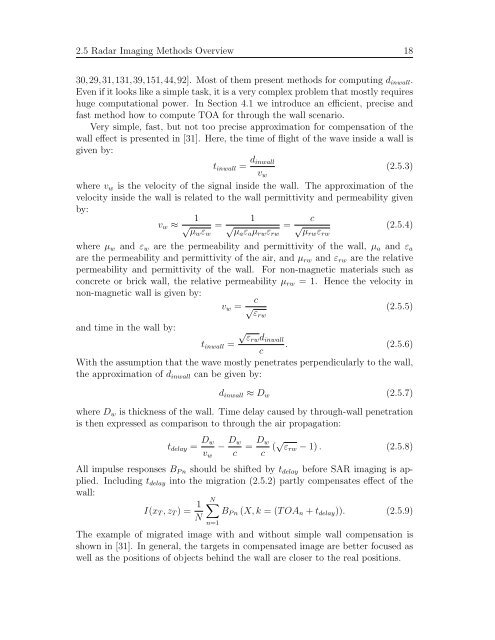Through-Wall Imaging With UWB Radar System - KEMT FEI TUKE
Through-Wall Imaging With UWB Radar System - KEMT FEI TUKE
Through-Wall Imaging With UWB Radar System - KEMT FEI TUKE
Create successful ePaper yourself
Turn your PDF publications into a flip-book with our unique Google optimized e-Paper software.
2.5 <strong>Radar</strong> <strong>Imaging</strong> Methods Overview 18<br />
30,29,31,131,39,151,44,92]. Most of them present methods for computing dinwall.<br />
Even if it looks like a simple task, it is a very complex problem that mostly requires<br />
huge computational power. In Section 4.1 we introduce an efficient, precise and<br />
fast method how to compute TOA for through the wall scenario.<br />
Very simple, fast, but not too precise approximation for compensation of the<br />
wall effect is presented in [31]. Here, the time of flight of the wave inside a wall is<br />
given by:<br />
tinwall = dinwall<br />
vw<br />
(2.5.3)<br />
where vw is the velocity of the signal inside the wall. The approximation of the<br />
velocity inside the wall is related to the wall permittivity and permeability given<br />
by:<br />
vw ≈<br />
1<br />
√ µwεw<br />
=<br />
1<br />
√ µaεaµrwεrw<br />
=<br />
c<br />
√ µrwεrw<br />
(2.5.4)<br />
where µw and εw are the permeability and permittivity of the wall, µa and εa<br />
are the permeability and permittivity of the air, and µrw and εrw are the relative<br />
permeability and permittivity of the wall. For non-magnetic materials such as<br />
concrete or brick wall, the relative permeability µrw = 1. Hence the velocity in<br />
non-magnetic wall is given by:<br />
and time in the wall by:<br />
vw = c<br />
√ εrw<br />
√ εrwdinwall<br />
(2.5.5)<br />
tinwall =<br />
. (2.5.6)<br />
c<br />
<strong>With</strong> the assumption that the wave mostly penetrates perpendicularly to the wall,<br />
the approximation of dinwall can be given by:<br />
dinwall ≈ Dw<br />
(2.5.7)<br />
where Dw is thickness of the wall. Time delay caused by through-wall penetration<br />
is then expressed as comparison to through the air propagation:<br />
tdelay = Dw<br />
vw<br />
− Dw<br />
c<br />
= Dw<br />
c (√ εrw − 1) . (2.5.8)<br />
All impulse responses BP n should be shifted by tdelay before SAR imaging is applied.<br />
Including tdelay into the migration (2.5.2) partly compensates effect of the<br />
wall:<br />
I(xT , zT ) = 1<br />
N<br />
N�<br />
BP n (X, k = (T OAn + tdelay)). (2.5.9)<br />
n=1<br />
The example of migrated image with and without simple wall compensation is<br />
shown in [31]. In general, the targets in compensated image are better focused as<br />
well as the positions of objects behind the wall are closer to the real positions.








